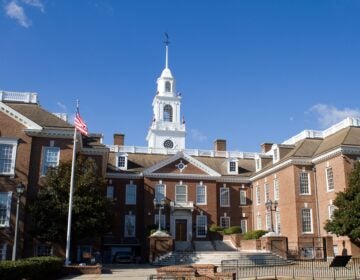Delaware officially changes the Coastal Zone Act
Gov. John Carney, D-Delaware, signed legislation Wednesday that aims to revamp the Coastal Zone Act and make way for the repurposing of abandoned industrial sites in an attempt to make Delaware more business-friendly.
Carney, who has touted the controversial bill, said it strikes a balance between protecting the environment and strengthening the economy.
“The most important thing we talked about during the campaign was creating an environment where businesses could come and create jobs,” he said at the signing event, held at the former General Chemical site in Claymont.
“This bill is a win-win opportunity for our state—a stronger cleaner environment with greater utilization of our industrial sites and additional jobs.”
The legislation, sponsored by State Rep. Ed Osienski, D-Newark, and State Sen. Bryan Townsend, D-Newark, creates a permitting process for the redevelopment of 14 industrial sites, including those that are abandoned or contaminated.
The bill, which has been in the works since 2014, also allows new bulk product transfer operations at sites that had piers before 1971, when former Delaware Governor Russ Peterson signed the CZA into law in 1971.
The legislation still places restrictions on some heavy industry uses that didn’t exist in 1971, such as oil refineries, steel mills and liquefied natural gas terminals.
Companies seeking a conversion permit must submit an application detailing the environmental and economic impacts of previous uses and planned redevelopment of the site, a proposal to offset any negative environmental impacts of industrial redevelopment and a plan to prepare the site for the long-term effects of sea-level rise.
The CZA, which was created to protect the Delaware Bay and the state’s shoreline from heavy industrial development, prohibited the transfer of bulk goods by ship, and also placed restrictions on repurposing abandoned property. An abandoned site could only be repurposed for its previous use.
There are currently three abandoned industrial sites in Delaware through the Coastal Zone Act, and two that are not in operation but are set to be restored—all in New Castle County.
Supporters of the bill say the CZA rules were too restricting on businesses and prevented new businesses from locating to Delaware. They say the bill will create new jobs and boost the economy.
Osienski said he still believes the CZA is a “landmark bill” that has accomplished most of what it was meant to achieve. He said his bill does not change that. However, some aspects of the CZA have caused businesses to leave Delaware, Osienski said.
“I envision good, responsible companies that are interested in investing in Delaware and continuing and expanding on the remediation of these sites, and also building here and developing here, and creating good career-building jobs,” he said.
“It’s great we’re having (the bill signing) here at the old General Chemical site where so many people were employed here in good paying jobs. They lost those jobs, and now they’re working in lower paying jobs. Our unemployment number isn’t the real issue, it’s the wage rate that’s the real issue, and what (the bill) will do in giving opportunities for heavy industry is to create good paying jobs.”
D2 Management, a real estate development and investment firm, through its affiliate Drawbridge Claymont, LLC, will begin the redevelopment of the former General Chemical site.
In 2015, the company acquired the 71-acre site, which includes a freight rail road and a 750-foot pier/docking facility with four mooring dolphins.
D2 Management plans to use the site for heavy industry, with construction already underway, including the building of a 13-acre railyard for petrochemical company Braskem America, to service their plant in Marcus Hook, Pa.
D2 Management’s president Keith Delaney said CZA regulations have been very challenging for businesses.
“We had a business plan, and without this bill we would have had to make a lot of sacrifices in the plan,” he said. “There wouldn’t be as many jobs, there wouldn’t have been as much economic development. And truly, this site would not have been brought back to what it was 20 years ago, and for us it would have been a shame.”
Delaney said it’s too early to predict the amount of jobs that will be created on the site, but guesses there will be about 1,000 jobs during construction and a couple hundred full-time jobs. He also said he believes the legislation will make Delaware more competitive when it comes to locating an industrial business.
However, environmentalists have rallied against the bill throughout the legislative process, arguing it puts the coastal zone at risk for contamination, and say an increase of bulk product transfer creates the risk of hazardous spills. They also argued there wasn’t enough public input on the bill.
While in the House, representatives approved several amendments to the bill to address various concerns. One of these amendments states that any product transported ship to shore must be used at the facility that’s applied for the permit, or other facilities within the coastal zone. Anything exported off the Delaware coast, also must come from within the coastal zone.
Representatives also passed an amendment that requires DNREC to report any environmental effects, while the Delaware Economic Development Office is required to report the economic impact.
Despite those changes to the bill, environmentalists like Matt DelPizzo of the Delaware Audubon Society still has concerns.
“We know that there’s some exclusions on what can be carried in bulk transfer, but you do have petroleum products that are going up and down the river daily, and of course any kind of accident with them could dramatically harm all the good things that have happened on the river since 1971,” he said.
“Worst case scenario, you could have spring migration of the shore birds and the horseshoe crabs in the estuary and you could have a spill—which they still have spills regardless what they say about technology. If you had a spill that coincided with when the birds and horseshoe crabs were here, you could do irreparable harm to the environment, so that’s the worst case scenario.”
DelPizzo also has concerns that DNREC is too overwhelmed to keep its eyes on every industrial operation, and that the state may even make more changes to the CZA in the future.
“It’s kind of the Last Supper for the Coastal Zone, to paraphrase, and the governor is playing Judas as far as we’re concerned,” he said. “There won’t be much of this left afterwards, because as we know this is the camel, the proverbial camel, with his nose under the tent. We know they certainly can come back again and again to even take more of it.”
Osienski and Department of Natural Resources and Environmental Control Secretary Shawn Garvin say they’re confident the environment will be protected under the new regulations.
“Technology has changed in this industry—technology for keeping underground tanks safe for bulk product transfer,” Osienski said. “The mixture of new technology, and DNREC learning from past mistakes, I’m very confident industry can operate here and still be good for our coastline.”
Delaney said his company is committed to following environmental regulations, and that DNREC and EPA have held them accountable throughout its acquirement of the former General Chemical site.
“I can say with a straight face they have not let us get an inch, they have not let one sentence go by without scrutiny and make sure it’s accurate and done correctly. And frankly, it’s our policy,” he said. “We’re looking to be stewards of the environment. This site is very dirty—the arsenic, the DDT and other things. I fully except DNREC to be all over us, make sure the policies and controls are in place. And frankly, from our perspective, we wouldn’t want it any different. We’re not looking to cut corners.”
Delaney said bulk product transfer won’t be used on the site until a heavy industrial user is identified. However, it is likely it will occur when a business uses the site for its operations.
“If you bring in someone who wants to spend a billion dollars to build a factory, they want to be able to ship their goods all over the world and bring in raw materials from all over the world, and we have that asset here,” Delaney said.
Starting in October, the state will have two years to listen to stakeholders and implement the new regulations. Garvin also promises to be transparent, and said the state will hold town hall events to inform the public on what’s being done.
“We don’t know what kind of operations will be at the locations—we want to put the framework together on the regulations that will make that quick, but can be very clear on what’s expected to balance that environmental side while also helping the economy,” he said.
“We’re going to make sure they support the coastal zone, which will have some limitations, and then make sure it’s being done in an environmentally-friendly, technological way—and a lot has happened over the years in terms of bulk product transfer and the way they go about doing that.”
WHYY is your source for fact-based, in-depth journalism and information. As a nonprofit organization, we rely on financial support from readers like you. Please give today.





